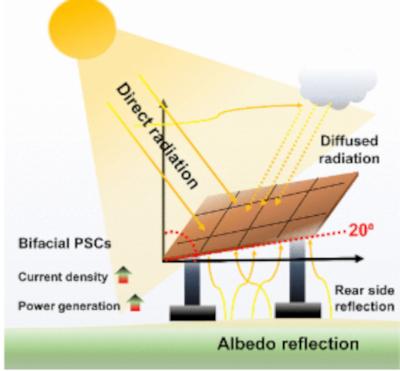Bifacial perovskite solar cells (Bi-PSCs) have attracted substantial attention due to their potential for enhanced power generation, suitability for integration into building structures and applicability in multijunction PV systems. Recently, researchers from the Indian Institute of Technology Bombay reported the fabrication of efficient Bi-PSCs and investigated their unique properties using various characterization techniques, including Lambertian reflection effects through tilt angle arrangements and bottom albedo illuminations.
The control device achieved a maximum power conversion efficiency (PCE) of 17.46% under front-side 1 Sun AM1.5G illumination. A significant influence of ground Lambertian reflection was observed with tilt angle variations, resulting in an increase in PCE from 17.46% → 18.82% as the tilt angle reached 20°. Additionally, enhancing the rear-side albedo to 0.5 Sun yielded a maximum PCE of 26% with a bifaciality factor of ∼90% at a tilt angle of 20°.
Consequently, the synergistic effect of 0.5 Sun albedo and a 20° angular light inclination led to the development of Bi-PSCs with an efficiency of 26.46%.
SCAPS-1D simulations were further employed to validate the experimental Lambertian reflection effects. Moreover, the Bi-PSCs exhibited intrinsic self-encapsulation and chemical robustness (T80 for 2000 h in the N2 atmosphere).
This study anticipates that cost-effective and highly efficient Bi-PSCs will emerge as a leading PV technology in both single-junction and tandem PV configurations for electricity generation in the near future.


